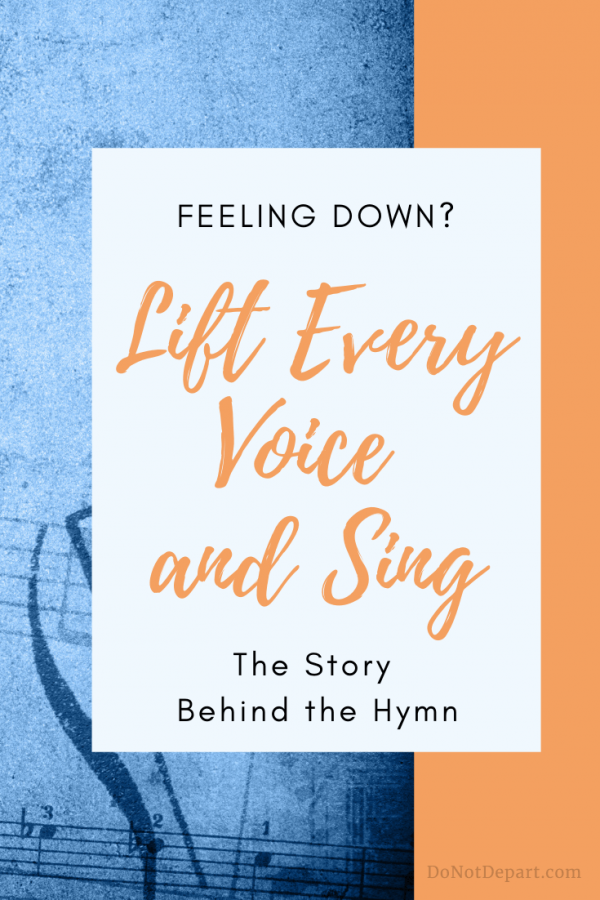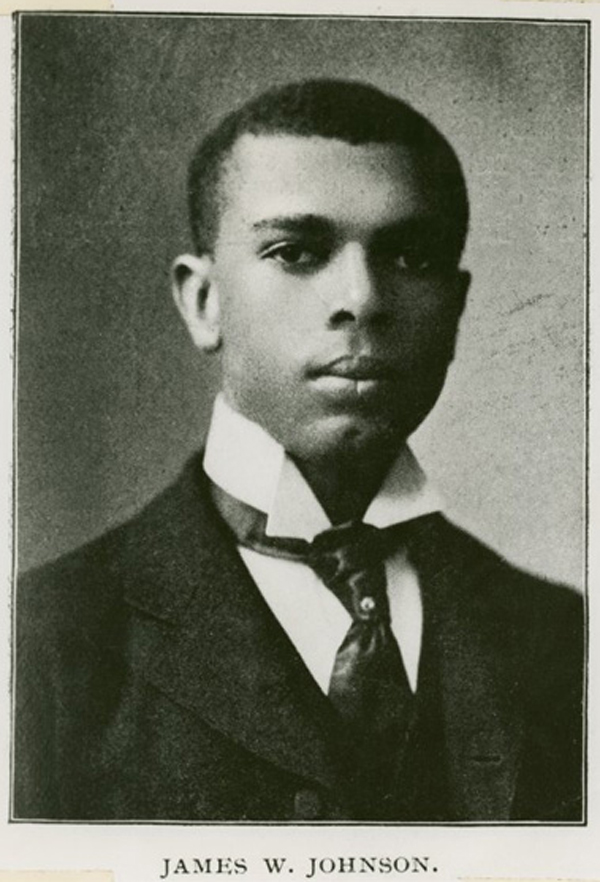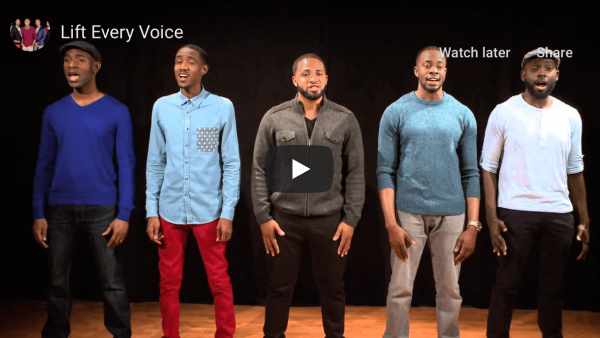When you feel down, lift your voice and sing. Practice hope by remembering your past and knowing who to trust for your future. Read the story behind the hymn, “Lift Every Voice and Sing.”

Power of a Voice
You’re likely hearing it, too, wherever you are. The United States is trembling with heightened fervor the past few weeks.
- Voices are crying out in pain over racial injustice.
- Ears are listening to stories.
- Feet are marching in the streets of large cities and small towns.
When the noise gets loud enough, it catches everyone’s attention.
Voices have that power.
We’re looking all month at beloved hymns sung in the Christian tradition, and listening to the voices that wrote them as they echoed the voice of Jesus. (See all the hymns here.)
We’re reminded of their importance to us today, as we answer the following questions:
- Do words from over a century ago mean anything new in our lives?
- What can we learn from older hymns?
- How can they help us right now?
James Weldon Johnson, Poet, Teacher, Lawyer, Leader
On June 17, 1871, a baby Black boy was born in Jacksonville, Florida, named James Weldon Johnson. Because his mother was a musician and a public school teacher, Johnson grew up educated, first by her, then at Edwin M. Stanton School.
At age 16, Johnson entered Atlanta University, a historically Black college. He graduated in 1894, with dreams of helping other Black people advance.
Johnson and his younger brother John Rosamond Johnson moved to New York City to escape the South in the early 1900s. They wrote songs together (Rosamond was a composer) and even had some success on Broadway.

While accomplished in many areas (Johnson was an educator, a lawyer, a civil rights activist, a leader in the NAACP), he is perhaps best known in our times as the author of “Lift Every Voice and Sing.”
Johnson lived through racial segregation, investigated brutal lynchings, and experienced economic inequalities.
How could he write a hymn of such hope?
Lift Every Voice and Sing
Not yet 30 years old, Johnson paced back and forth on his front porch, reaching for words. He had already written the first lines, in which “the spirit of the poem had taken hold” of him.
Lift every voice and sing,
Till earth and heaven ring,
Ring with the harmonies of Liberty;
Let our rejoicing rise
High as the listening skies,
Let it resound loud as the rolling sea.
He had to keep going.
By the time he finished the last stanza, he was crying.
God of our weary years,
God of our silent tears,
Thou who has brought us thus far on the way;
Thou who has by Thy might
Led us into the light,
Keep us forever in the path, we pray.
Johnson says, “I could not keep back the tears, and made no effort to do so.”
The completed poem, later to become a song, is witness to what hope can do, what God can do.

3 Things To Do When Down
Often when we are down, we stay there. We’re quiet. We definitely don’t sing. We dare not look ahead to the future.
But if we can practice the truths in this song, with God’s help, we, too, can rise again.
What can “Lift Every Voice and Sing” teach us to do?
1. PRACTICE HOPE
Johnson practiced hope by singing it aloud. He lifted his voice “til earth and heaven ring,” for the “listening skies” to hear and louder than the “rolling sea.”
If Johnson could practice hope as a Black man in an era of Jim Crow, white supremacy, and racial hatred, we can practice hope today in the current fight against racial inequality.
Sing your hope aloud. Make it active. Proclaim it as real.
2. REMEMBER THE PAST
Johnson also looked backwards.
Sometimes we don’t want to look behind us. It’s too uncomfortable. Even painful. Johnson knew the stony road, the chastening rod, the days when “hope unborn had died.”
As a young man, Johnson spent a summer teaching students who lived in the backwoods of Georgia. His Black students had experienced and heard stories of brutality and poverty. Their resilience made an impression on Johnson.
But often from “the dark past” are lessons we can use in the present. From that experience, Johnson said, “I laid the first stones in the foundation of faith in them on which I have stood ever since.”
The past can remind us we have survived to see a new day. It can give us strength to press on.
Sing a song full of the faith that the dark past has taught us,
Sing a song full of the hope that the present has brought us;
Look back at how far you’ve come. Remember the past to strengthen your faith.
3. TRUST GOD FOR THE FUTURE
And finally, Johnson knew where to put his hope. He placed it on God for his future.
Lest our feet stray from the places, our God, where we met Thee,
Lest, our hearts drunk with the wine of the world, we forget Thee;
Shadowed beneath Thy hand,
May we forever stand,
True to our God,
True to our native land.
Your future is a valuable treasure held out to you to give you hope.
Knowing where to position your hope can mean the difference between misery or joy.
Lift YOUR Voice and Sing, Too
“Lift Every Voice and Sing” was first recited in 1900 by 500 Black students.
Johnson was now the principal of Edwin M. Stanton School in Jacksonville, Florida. His students recited the poem to celebrate a school visit from Booker T. Washington and as a tribute to President Abraham Lincoln’s birthday. Later, Johnson’s brother Rosamond composed the music to transform it into a song.
It’s been sung around the world ever since. In less than 20 years, it became so popular it was adopted as the Black national anthem. It increased in popularity again during the civil rights movement in the 1950s and ’60s.
It has since been quoted at a Presidential Inauguration (Reverend Joseph Lowery’s benediction for President Barack Obama in 2009); mixed and remixed as landmark performances by artists for decades; sung at countless graduations and in concert halls; and glued onto the back flap or printed in hymnals for church pews.
It lives on today in hearts and mouths of people of every color who need words of celebration, faith in God now, and hope for victory ahead.
Lift your voice and sing, too.
• Read all the lyrics of “Lift Every Voice and Sing”
• Read more: Till Victory Is Won: The Staying Power Of ‘Lift Every Voice And Sing’
• Listen to “Lift Every Voice and Sing” sung by Committed
Have you sung “Lift Every Voice and Sing“? What’s a favorite hymn of yours through the years?


I shared the link to this post on NanaHood. I hope that’s okay. http://nanahood.com/the-power-of-a-voice. Thank you for writing this and sharing the video. I loved it!
Yes, I appreciate you sharing the good news in this hymn, Teresa! I agree with you in your post: there is so much we don’t understand. But we do understand the power of a voice. Thanks for pouring out your heart; it’s a beautiful expression.
Lifting my voice and singing right along with you, Lisa! Thanks for giving us such a detailed back story of how this beautiful hymn came to be. Blessings!
I wish I could hear your voice in person and sing with you, Martha! Singing together with other people is one of the things I miss about our corona world. :( I loved learning about this song too; it gives me hope. Blessings to you, friend.
Thank you for the very good reminder about this hymn. Now I will be singing it (in my head) for the rest of the day. I never knew the story of the songwriter. It’s amazing that he could write such a hopeful song.
Yes, I am amazed that he was able to write with such hope, too, living under such oppression. (It gives me no excuse for not using my gifts!) And his words have had such staying power. They continue to give hope, which we need now too. I’m thankful for God’s gifts of grace to those who compose songs through the ages, and our ability to preserve them and keep them alive for several generations now. God gives so much more grace than I can imagine.
I love many of the old hymns – and strangely, they are the words that I can remember when I need to sing. That has been my experience, sometimes you need to flood your mind with hope and a good way of doing that is to sing praises to God. Thanks, will remember to look back so that I can look ahead! Faith on Fire #15
The words to old hymns often come quickly to my mind, too, Sharon, even if I haven’t sung them in years! I guess it’s true that what we learned as a child stays with us more than we realize. And that can be a good thing in regard to hymns. :)
THank you for this story and hymn. I was not aware that this is a black national anthem. I’m a suck for all male voices so I really enjoyed the youtube inclusion. I’m you neighbor on Grace and Truth and “ironically” I shared a hymn study as well.
Thanks, Mandy. I learned there is SO much history behind this hymn. It’s been around a long while and has influenced a lot of people.
I just watched the video you posted of the virtual choir on A Mighty Fortress. I was already singing the song in my head just reading the words. Beautiful! I’m glad people are being creative enough even in the midst of the pandemic to still praise God together however they can!